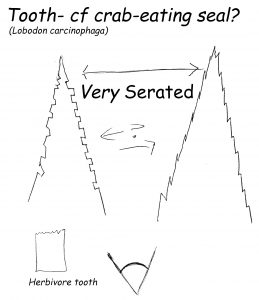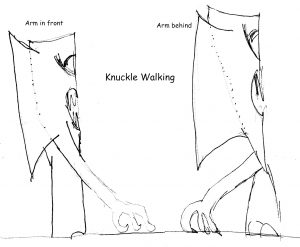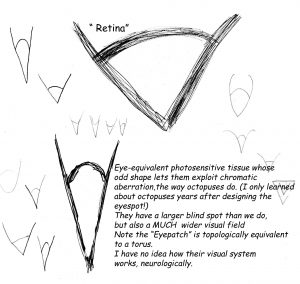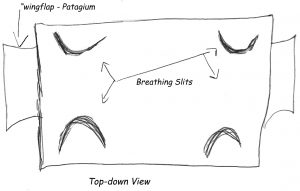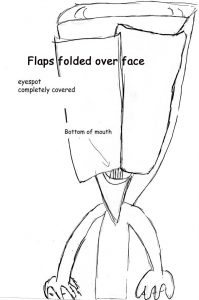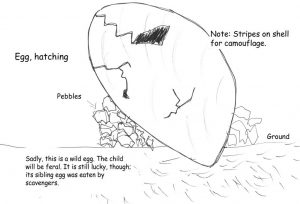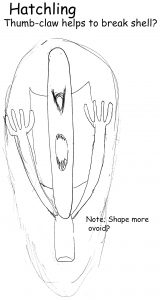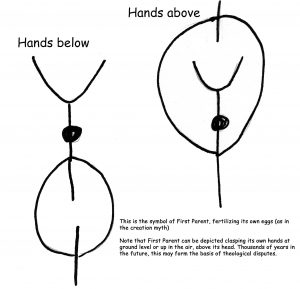In high school, I created aliens.
When I was in high school, I read James White, and Janet Kagan, and Wayne Douglas Barlowe. I read Larry Niven and Stanley Weinbaum. I read Hal Clement. But I also read Stephen J. Gould.
I learned about the concept of the Bauplan – the primitive concept of the ‘body plan’ that early taxonomists used in their attempts to classify phyla, and the more modern versions used today. The tetrapod Bauplan that we all adhere to – four limbs, a head, a torso… eyes… a spine… a brain… – and the others. Arthropods. Molluscs. Annelids. Organisms that were radially symmetrical instead of bilaterally.
I learned about the Cambrian Explosion, and about the Ediacaran fossils that antedate it. Baupläne that were nothing like what now exists.
I learned about the role of historical contingency. “Survival of the fittest” isn’t as straightforward as you might think: circumstances change, and what was suitable one day may be wholly unsuitable the next. There’s no set goal to evolution, no specific target.
And I looked at the aliens in the books I was reading. And I wondered, how alien were they really.
I decided to try creating intelligent aliens based not on what I needed for a story, but on an alien Bauplan. A body that would be like nothing we knew.
I remember sitting in history class (well, I only remember doing these in one particular classroom, and it’s where I took history class, but these weren’t all on one occasion, so they probably occurred elsewhere too) and sketching so many different false starts.
There was the spiderweb creature. It had entire spideroids as its appendages: one at each of four corners. The mind would be in the fibres of the web, and… no. Too fragile, and too biologically implausible. How would this even have evolved? Complex appendages, sure, but they’d need to be on a complex organism.
There was the enormous rectangular-prism monolith creature. It 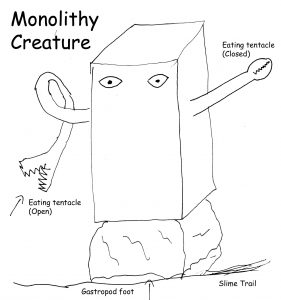 had a slime-secreting gastropod foot the size of a hundred-year-old tree stump, and tentacles with serrated maws like alligator clips… and I remember that there was an eye. And gill slits on its top facet. And it would have a silicaceous carapace – perhaps it could alter the carapace’s optical properties at will so that it could make itself have a mirror finish, and thereby sneak into a herd of prey? But… ultimately, it seemed boring. It wasn’t an alien, it was a monster.
had a slime-secreting gastropod foot the size of a hundred-year-old tree stump, and tentacles with serrated maws like alligator clips… and I remember that there was an eye. And gill slits on its top facet. And it would have a silicaceous carapace – perhaps it could alter the carapace’s optical properties at will so that it could make itself have a mirror finish, and thereby sneak into a herd of prey? But… ultimately, it seemed boring. It wasn’t an alien, it was a monster.
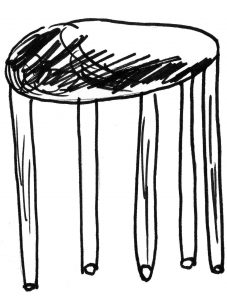 There were the black-and-white rounded patio tables that ran around on five legs and talked via radio pulses. So their language would be very high-pitched, shrill. Rapid-fire modulated bleeping, like a fax machine, or – although I devised these before I ever heard modem noises – a modem. The “WIIINIIIP”, they’d call themselves. Or “WEENEEP”. In all-caps. Their planet wouldn’t have much atmosphere. They would generate laser pulses from their legs, and shoot prey with them, and then use a feeding leg to suck up the liquefied remains. They wouldn’t see like we would, but they’d absorb light via the black on the table-disc part. They’d have five sexes… or maybe they’d just need five to reproduce? Anyway, they’d hold their mating legs together, and their mating feet would all fuse together and fall off, and that tiny little thing, the central lump, the fusion disc, would form a new baby. And then… what? What else could I do with these creatures? What kind of a society could they build? They had no appendages for holding tools – at most, they could push things around. And when I thought about their planet, it seemed empty. They didn’t feel as if they could be real. They were a concept, not a creation.
There were the black-and-white rounded patio tables that ran around on five legs and talked via radio pulses. So their language would be very high-pitched, shrill. Rapid-fire modulated bleeping, like a fax machine, or – although I devised these before I ever heard modem noises – a modem. The “WIIINIIIP”, they’d call themselves. Or “WEENEEP”. In all-caps. Their planet wouldn’t have much atmosphere. They would generate laser pulses from their legs, and shoot prey with them, and then use a feeding leg to suck up the liquefied remains. They wouldn’t see like we would, but they’d absorb light via the black on the table-disc part. They’d have five sexes… or maybe they’d just need five to reproduce? Anyway, they’d hold their mating legs together, and their mating feet would all fuse together and fall off, and that tiny little thing, the central lump, the fusion disc, would form a new baby. And then… what? What else could I do with these creatures? What kind of a society could they build? They had no appendages for holding tools – at most, they could push things around. And when I thought about their planet, it seemed empty. They didn’t feel as if they could be real. They were a concept, not a creation.
I honestly don’t recall what order I made these in. But eventually, I decided to be methodical. What were the organs a creature would need? Or rather, what functions did I want these organs to fulfill?
It needed to be able to perceive its environment. It needed some way to see. But not necessarily eyes, not the way we understand them. As long as there was something photosensitive.
It needed to be able to take in food. A mouth.
It needed to be able to move around. It needed to be able to breathe. It needed to be able to reproduce.
And it needed to be able to manipulate its environment.
Eventually, I drew it. The first version was more cylindrical, but I 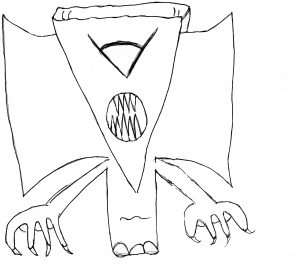 sketched it again and again as the weeks went by, and the top broadened until it looked more like an inverted isosceles triangle – I remember, some months later, being surprised by how un-triangular the first version was.
sketched it again and again as the weeks went by, and the top broadened until it looked more like an inverted isosceles triangle – I remember, some months later, being surprised by how un-triangular the first version was.
It had a giant head – it was a giant head, almost. There was a giant mouth, with lots and lots of serrated teeth… and it didn’t have a jaw. Or… well, not a temporomandibular joint. Its jaw was not separate, its jaw was fused. I don’t know that the vocabulary exists to describe this properly. Basically, its mouth was always open to a fixed width and length.
There was one thick central leg, with a rounded elephantlike foot. It would hop – or, more precisely, it would move in a combination of hopping and knuckle walking. Sort of as if it was on crutches. And knuckle walking implies hands. Big hands. Giant hands. Two of them. With claws. The adults don’t have opposable thumbs, but the fingers are more curved towards each other than on human hands. And they were webbed.
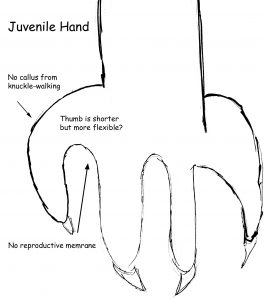 |
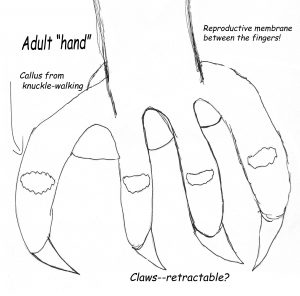 |
And a tongue. And breathing slits. And four rounded nails on the foot – which was, as I said earlier, elephantlike. Four fingers on the hands, four toes on the foot.
And, above the arms, protruding from the headbody: Wings.
Well, not wings, not precisely. They’re big, and they’re flappy, but they’re not for flying. At best they’re for gliding. If they jump off a cliff, they can steer their descent. If your definition of “patagium” is broad enough to include a flap that’s not stretched between anything, then it’s a patagium. And they can fold it across themselves to keep warm, or to serve as eyelid-equivalents when they sleep.
They’re called – they call themselves – K’Sin’T’Xiks. (Yes, there’s a difference between the ‘x’ sound and the ‘ks’ sound.) And they call their world G’Jin’D’Stek.
One detail I’m pleased with is that often, writers will say that an alien species has a language that we can’t pronounce properly – their vocal apparatus is more complex than ours and therefore they have more phonemes than we do, which are typically represented by non-letter characters. The K’Sin’T’Xiks are the inverse of that: their vocal apparatus – and thus their phoneme range – is more limited than ours. To speak like a K’Sin’T’Xiks, open your mouth until you’re in the right position to vocalize the sound “ih”. Then open it a little more until you’re almost in the right position to vocalize the sound “eh”; if you can actually vocalize the sound “eh”, you’ve gone too far. Then tense your jaw and don’t move it.
Their language doesn’t have a name. They’ve never needed to name it, because they’ve never encountered a second language. This isn’t because everyone on the planet speaks the same language… it’s because most of them don’t speak language at all
The K’Sin’T’Xiks are in their equivalent of the Neolithic era (and I’ll admit that this is in part because I can’t extrapolate an entirely alien technology tree). They’re an apex predator, and a pretty successful one. Very adaptable, very prone to explore new territories when, for instance, glaciation makes land bridges, so they’ve spread across most of the planet. But there’s a hitch.
They’re an oviparous species… but they’re not nest-tenders. The happy couple gaze into each other’s vision patches, lean their heads against each other, clasp each other’s enormous hands… and in that act of handclasping, the eggs are fertilized. Both the eggs, because they’re hermaphrodites who fertilize each other. They bury their eggs in a safe spot, and wander off.
I once read a story in which, in the background, anthropologists from different species are arguing about what had to be the First Inventions, the ones without which civilization could not have begun. And the anthropologist from an aquatic species scoffs at the notion that it’s fire, and argues that the first invention had to be ropes and nets, because how else could you keep things from floating away.
In the K’Sin’T’Xiks, the invention which allowed the onset of civilization was not fire. It was not the stone ax. It was not agriculture or domestication. It was child-rearing.
Without the instinct to raise your offspring and teach them to survive, each generation has to learn everything for itself. It’s been barely a thousand years since the onset of the hatchling-raiser caste. And raisers are still quite rare. There’s maybe four million K’Sin’T’Xiks on the planet…. of which maybe a few tens of thousands are part of the proto-civilization. The others are… the word “savages” has a lot of negative connotations. Let’s say “feral”.
I mentioned earlier that the adults don’t have opposable thumbs. The hatchlings do. As they age, the thumbs become less opposable, and fine manipulation becomes more difficult. This is another advantage to digging up someone else’s eggs and bringing them back to civilization to hatch and be taught: you need the children to do the detail work. They haven’t yet figured out the connection between malnutrition and delayed puberty, but they’ve noted that when times are bad, the children keep their thumbs longer, and are able to learn more skills and do more things.
They’ve recently developed the basics of agriculture. They’re mostly obligate carnivores (what else could you expect with teeth like that?), but once you have agriculture, ranching becomes easier: the prey animals (mostly trundlers) are less likely to try to escape if you supply them with food. Plus there are the occasional medicinal 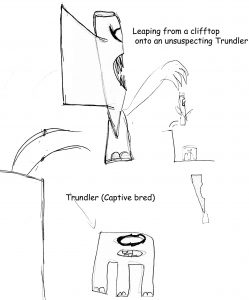 herbs, and flavorsome spices. Note that ranching is a derivative of child-rearing: what if you find trundler hatchlings and, rather than eating them or ignoring them, you stampede them into an enclosure? And then you give them big piles of leaves and fruit to eat, and they stop trying to escape. And they become adults, and eventually they lay their own eggs in the enclosure! And then you kill and eat the adults, and start over – and this time, you don’t even have to find hatchlings to stampede into the enclosure. It helps that you don’t need to eat every day.
herbs, and flavorsome spices. Note that ranching is a derivative of child-rearing: what if you find trundler hatchlings and, rather than eating them or ignoring them, you stampede them into an enclosure? And then you give them big piles of leaves and fruit to eat, and they stop trying to escape. And they become adults, and eventually they lay their own eggs in the enclosure! And then you kill and eat the adults, and start over – and this time, you don’t even have to find hatchlings to stampede into the enclosure. It helps that you don’t need to eat every day.
They’re gradually expanding their territory. Digging up the eggs buried by ferals, and bringing them in to civilization to hatch and raise and make into people. An important part of their culture, one which the raisers inculcate into the children as early as possible, is that you only mate in the approved mating grounds. Laying your eggs outside the approved mating grounds is bad, because of the possibility that the egg-fetchers won’t be able to find them. If they hatch in the wild, then they could become feral.
Raisers are rare because the children can’t just be taught to be raisers. They need a genetic propensity for those behaviors. The gene in question is present among the worldwide feral populations too, albeit at an even lower prevalence. Child-rearing could be re-invented elsewhere. A second civilization could be born on this planet. It just hasn’t, that’s all. Not yet – and, depending on how fast and how far the first one spreads – maybe not ever. And outside the context of child-rearing having been invented, that propensity is useless, like how dyslexia is survival-neutral outside the context of writing having been invented.
Very slowly, the raiser trait is spreading through the population. Raisers don’t favor their own eggs over those of the rest of the community – they don’t even keep track of who laid which egg, except insofar as whether it was laid by someone within the community, or just a feral – but communities with more raisers are more prosperous.
They’ve recently invented music – well, singing. A few of them have started independently working out the rudiments of figurative art; the raisers aren’t sure yet whether it’s useful. They have the basics of arithmetic – tally marks. They’re learning to redirect streams and make ponds. Some of the children can shape clay. I honestly don’t know if they’ve figured out how to make fire. They bury their dead.
They have no idea that they have a fossil record, or what that means. They’ve seen meteors, of course – what Neolithic population wouldn’t? – but they don’t know what they are, or what the connection is to the Nr’Tatek impact crater that shaped their evolutionary history. They don’t even know that Nr’Tatek is an impact crater. It’s just a place.
They have a creation myth. It tells of how, at the beginning of the world, First Parent K’San’J’Cha fertilized its own eggs and laid them in the sky. After the first people hatched, the fragments of the eggshells became the stars.
Writing is a long way off in their future, but they’ve got an oral tradition. They tell each other stories.
And at night, they dream.

